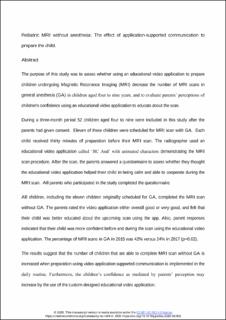| dc.contributor.author | Olloni, Signe Scheffmann | |
| dc.contributor.author | Mussmann, Bo | |
| dc.contributor.author | Villadsen, Nana | |
| dc.date.accessioned | 2021-08-20T07:58:45Z | |
| dc.date.available | 2021-08-20T07:58:45Z | |
| dc.date.created | 2020-11-18T09:37:06Z | |
| dc.date.issued | 2020-10-22 | |
| dc.identifier.issn | 1546-0843 | |
| dc.identifier.uri | https://hdl.handle.net/11250/2770471 | |
| dc.description.abstract | The purpose of this study was to assess whether using an educational video application to prepare children undergoing Magnetic Resonance Imaging (MRI) decrease the number of MRI scans in general anesthesia (GA) in children aged four to nine years, and to evaluate parents’ perceptions of children's confidence using an educational video application to educate about the scan. During a three-month period 52 children aged four to nine were included in this study after the parents had given consent. Eleven of these children were scheduled for MRI scan with GA. Each child received thirty minutes of preparation before their MRI scan. The radiographer used an educational video application called ‘HC And’ with animated characters demonstrating the MRI scan procedure. After the scan, the parents answered a questionnaire to assess whether they thought the educational video application helped their child in being calm and able to cooperate during the MRI scan. All parents who participated in the study completed the questionnaire. All children, including the eleven children originally scheduled for GA, completed the MRI scan without GA. The parents rated the video application either overall good or very good, and felt that their child was better educated about the upcoming scan using the app. Also, parent responses indicated that their child was more confident before and during the scan using the educational video application. The percentage of MRI scans in GA in 2015 was 42% versus 24% in 2017 (p=0.02). The results suggest that the number of children that are able to complete MRI scan without GA is increased when preparation using video application supported communication is implemented in the daily routine. Furthermore, the children’s confidence as mediated by parents’ perception may increase by the use of the custom-designed educational video application. | en_US |
| dc.language.iso | eng | en_US |
| dc.publisher | Elsevier | en_US |
| dc.relation.ispartofseries | Journal of Radiology Nursing;Volume 40, Issue 1 | |
| dc.rights | Attribution-NonCommercial-NoDerivatives 4.0 Internasjonal | * |
| dc.rights.uri | http://creativecommons.org/licenses/by-nc-nd/4.0/deed.no | * |
| dc.subject | Anesthesia | en_US |
| dc.subject | Pediatrics | en_US |
| dc.subject | Pediatric magnetic resonance imaging | en_US |
| dc.subject | MRI | en_US |
| dc.title | Pediatric MRI Without Anesthesia: The Effect of Application-Supported Communication to Prepare the Child | en_US |
| dc.type | Peer reviewed | en_US |
| dc.type | Journal article | en_US |
| dc.description.version | acceptedVersion | en_US |
| dc.rights.holder | © 2020 Association for Radiologic & Imaging Nursing. | en_US |
| cristin.ispublished | true | |
| cristin.fulltext | preprint | |
| cristin.fulltext | original | |
| cristin.qualitycode | 1 | |
| dc.identifier.doi | https://doi.org/10.1016/j.jradnu.2020.09.002 | |
| dc.identifier.cristin | 1849063 | |
| dc.source.journal | Journal of Radiology Nursing | en_US |
| dc.source.volume | 40 | en_US |
| dc.source.issue | 1 | en_US |

